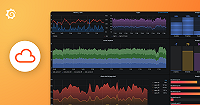This is documentation for the next version of Grafana Pyroscope documentation. For the latest stable release, go to the latest version.
Grafana Alloy
You can send data from your application using Grafana Alloy (preferred) or Grafana Agent (legacy) collectors. Both collectors support profiling with eBPF, Java, and Golang in pull mode.
The eBPF profiler only collects CPU profiles. Generally, natively compiled languages like C/C++, Go, and Rust are supported. They should have frame pointers enabled (enabled by default in Go). Refer to Troubleshooting unknown symbols for additional requirements and information.
Python is the only supported high-level language, as long as python_enabled=true.
Other high-level languages like Java, Ruby, PHP, and JavaScript require additional work to show stack traces of methods in these languages correctly.
Currently, the CPU usage for these languages is reported as belonging to the runtime’s methods.
Grafana Alloy is a vendor-neutral distribution of the OpenTelemetry (OTel) Collector. Alloy uniquely combines the very best OSS observability signals in the community. Alloy uses configuration files written in Alloy configuration syntax. For more information, refer to the Alloy configuration syntax.
Alloy is the recommended collector instead of Grafana Agent. New installations should use Alloy.
The instructions in this section explain how to use Alloy.
Note
Refer to Available profiling types for a list of supported profile types.
Legacy collector, Grafana Agent
Caution
Grafana Alloy is the new name for our distribution of the OTel collector. Grafana Agent has been deprecated and is in Long-Term Support (LTS) through October 31, 2025. Grafana Agent will reach an End-of-Life (EOL) on November 1, 2025. Read more about why we recommend migrating to Grafana Alloy.
Grafana Agent is a legacy tool for collecting and forwarding profiling data. Agent supports for eBPF and Golang in pull mode. For information about Agent, refer to Grafana Agent Flow.
Instructions for using Grafana Agent are available in documentation for Pyroscope v1.8 and earlier.
eBPF profiling
eBPF (Extended Berkeley Packet Filter) is a modern Linux kernel technology that allows for safe, efficient, and customizable tracing of system and application behaviors without modifying the source code or restarting processes.
Benefits of eBPF profiling:
- Low overhead: eBPF collects data with minimal impact on performance.
- Versatile: eBPF can trace system calls, network packets, and even user-space application logic.
- Dynamic: No need to recompile or restart applications. eBPF allows for live tracing.
Set up eBPF profiling
- Ensure your system runs a Linux kernel version 4.9 or newer.
- Install a collector, such as Alloy, on the target machine or container.
- Configure Alloy to use eBPF for profiling. Refer to the eBPF documentation for detailed steps.
- The collector collects eBPF profiles and sends them to the Pyroscope server.
Supported languages
The eBPF profiler only collects CPU profiles. Generally, natively compiled languages like C/C++, Go, and Rust are supported. They should have frame pointers enabled (enabled by default in Go). Refer to Troubleshooting unknown symbols for additional requirements and information.
Python is the only supported high-level language, as long as python_enabled=true.
Other high-level languages like Java, Ruby, PHP, and JavaScript require additional work to show stack traces of methods in these languages correctly.
Currently, the CPU usage for these languages is reported as belonging to the runtime’s methods.
Golang profiling in pull mode
In pull mode, the collector periodically retrieves profiles from Golang applications, specifically targeting the pprof endpoints.
Benefits of Golang profiling in pull mode
- Non-intrusive: No need to modify your application’s source code.
- Centralized profiling: Suitable for environments with multiple Golang applications or microservices.
- Automatic: Alloy handles the pulling and sending of profiles, requiring minimal configuration.
Set up Golang profiling in pull mode
- Ensure your Golang application exposes pprof endpoints.
- Install and configure Alloy on the same machine or container where your application runs.
- Ensure Alloy is set to pull mode and targeting the correct pprof endpoints. For step-by-step instructions, visit the Go (Pull Mode) documentation.
- The collector queries the pprof endpoints of your Golang application, collects the profiles, and forwards them to the Pyroscope server.
Receive profiles from Pyroscope SDKs
Alloy can receive profiles from applications instrumented with Pyroscope SDKs through the pyroscope.receive_http component. This approach provides several key advantages:
- Improved performance by sending profiles to a local Alloy instance instead of over the internet to Grafana Cloud, reducing latency and application impact
- Separation of infrastructure concerns from application code - developers don’t need to handle authentication, tenant configuration, or infrastructure labels in their code
- Centralized management of authentication and metadata enrichment (for example, Kubernetes labels, business labels)
This capability is not available in the legacy Grafana Agent.
Set up profile receiving
- Configure your application with a Pyroscope SDK pointing to the
pyroscope.receive_httpAlloy component. - For step-by-step instructions, refer to the Receive profiles from Pyroscope SDKs documentation.
Next steps
Whether using eBPF for versatile system and application profiling or relying on Golang’s built-in pprof endpoints in pull mode, Alloy collectors offer streamlined processes to gather essential profiling data. Choose the method that best fits your application and infrastructure needs.


